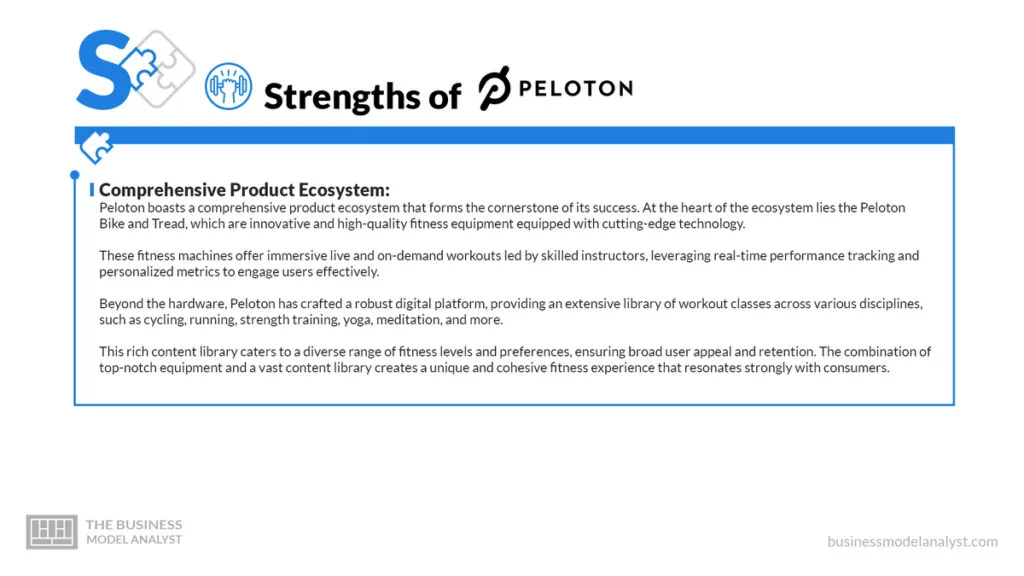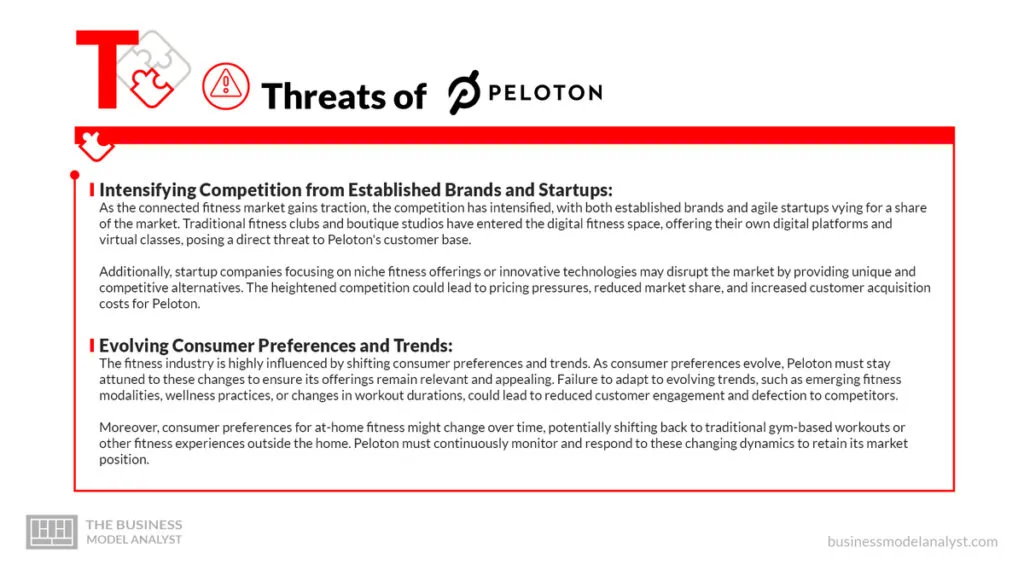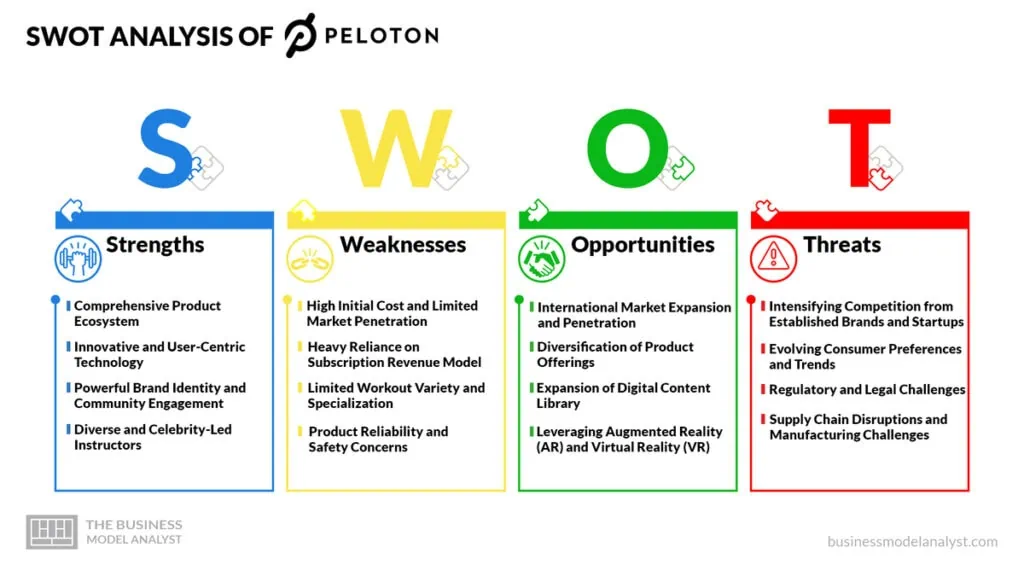Peloton is a rapidly growing and innovative fitness technology company that has revolutionized the way people approach home-based fitness and wellness. Founded in 2012, the company has emerged as a dominant player in the connected fitness market, providing interactive fitness equipment and digital content that allows users to access live and on-demand workout classes from the comfort of their homes.
The Peloton experience combines state-of-the-art stationary bikes, treadmills, and other fitness equipment with a vast library of engaging and motivational classes taught by world-class instructors. In this Peloton SWOT analysis, we will examine the strengths, weaknesses, opportunities, and threats facing the company as it continues to expand its reach and influence in the fitness industry.
Contents
Peloton Strengths

From its cutting-edge product ecosystem and user-centric technology to its strong brand identity and global expansion strategy, below are some of the core strengths that have contributed to Peloton’s market dominance and continued growth.
- Comprehensive Product Ecosystem
Peloton boasts a comprehensive product ecosystem that forms the cornerstone of its success. At the heart of the ecosystem lies the Peloton Bike and Tread, which are innovative and high-quality fitness equipment equipped with cutting-edge technology.
These fitness machines offer immersive live and on-demand workouts led by skilled instructors, leveraging real-time performance tracking and personalized metrics to engage users effectively.
Beyond the hardware, Peloton has crafted a robust digital platform, providing an extensive library of workout classes across various disciplines, such as cycling, running, strength training, yoga, meditation, and more.
This rich content library caters to a diverse range of fitness levels and preferences, ensuring broad user appeal and retention. The combination of top-notch equipment and a vast content library creates a unique and cohesive fitness experience that resonates strongly with consumers.
- Innovative and User-Centric Technology
Peloton’s commitment to innovation and user-centric technology is a key strength driving its competitive advantage. The company continuously invests in research and development to enhance its products and digital platform, staying ahead of market trends and consumer expectations.
The integration of state-of-the-art features like touch-screen displays, heart rate monitoring, and real-time performance metrics elevates the overall workout experience for users.
Additionally, Peloton leverages cutting-edge software and data analytics to offer personalized recommendations, track progress, and encourage engagement. This data-driven approach allows the company to understand user behavior better, optimize content, and continually refine its offerings to meet customer needs effectively.
- Powerful Brand Identity and Community Engagement
Peloton has masterfully cultivated a recognizable brand identity beyond fitness equipment. The brand represents a lifestyle, promoting the concept of connected fitness, empowerment, and community. The “Peloton community” is a significant aspect of its success, as users form a tight-knit, supportive network through virtual classes and social media engagement.
The company strategically fosters this community spirit through features like live leaderboard rankings, group challenges, and virtual high-fives during workouts. By creating an inclusive and motivating environment, Peloton has managed to forge a sense of belonging among its users, fostering loyalty and advocacy among its customers.
- Diverse and Celebrity-Led Instructors
A crucial factor that sets Peloton apart from its competitors is the diverse and talented team of instructors. Peloton handpicks world-class fitness experts from various disciplines, including cycling, running, yoga, and strength training. The instructors bring their unique personalities and coaching styles to the platform, catering to different preferences and ensuring a well-rounded fitness experience.
Moreover, Peloton has managed to attract celebrity instructors who possess significant social media followings, adding an extra layer of allure to the brand. This star power helps expand Peloton’s reach and attract new users, leveraging the influence of these celebrities to drive engagement and customer acquisition.
- Subscription Revenue Model and High Customer Retention
Peloton’s subscription-based revenue model is a key strength that has contributed significantly to its financial success. While the initial purchase of fitness equipment (Bike, Tread, or Bike+) serves as a one-time revenue stream, the subscription plan generates recurring revenue. Users pay a monthly fee to access the digital content library, enabling Peloton to maintain a stable revenue stream and build a predictable business model.
Furthermore, Peloton has managed to achieve an impressive customer retention rate. The engaging and addictive nature of its workouts, combined with the sense of community, keeps users returning for more. This high customer retention rate strengthens Peloton’s competitive position in the market and provides a solid foundation for sustainable growth.
- Aggressive Marketing and Strategic Partnerships
Peloton’s marketing efforts have been instrumental in establishing its brand and expanding its market share. The company employs a multichannel marketing strategy, utilizing social media, digital advertising, influencer partnerships, and traditional media to promote its products and services. Notably, Peloton has invested heavily in TV advertising campaigns, elevating brand visibility and appeal to a broader audience.
Strategic partnerships have also played a significant role in Peloton’s success. Collaborations with luxury hotels, residential complexes, and corporate wellness programs have expanded the brand’s reach and opened new sales channels. These partnerships tap into captive audiences and help Peloton gain exposure in diverse customer segments.
- Global Expansion and Diverse Revenue Streams
Peloton’s ambitious global expansion strategy has been another strength fueling its growth. The company has successfully ventured beyond its home market (the United States) to establish a solid international presence, tapping into fitness enthusiasts worldwide. This global footprint allows Peloton to diversify its revenue streams and mitigate the risks associated with relying solely on a single market.
Moreover, the company has introduced complementary products, such as the Peloton App, which allows users to access the digital platform without owning the Peloton equipment. This approach caters to budget-conscious consumers and opens additional revenue channels, broadening the company’s customer base and bolstering its overall financial performance.
Peloton Weaknesses

- High Initial Cost and Limited Market Penetration
One of Peloton’s prominent weaknesses lies in the high initial cost of its fitness equipment. The Peloton Bike, Tread, and Bike+ are premium products that come with a substantial price tag, making them less accessible to budget-conscious consumers. This pricing strategy creates a barrier to entry, limiting market penetration to a niche segment of fitness enthusiasts with the financial means to invest in these products.
Furthermore, the premium positioning of Peloton’s hardware may hinder its ability to reach a broader demographic, including price-sensitive consumers and those who prefer lower-cost alternatives. As a result, the company faces challenges in expanding its customer base beyond its current target market, potentially limiting its overall growth potential.
- Heavy Reliance on Subscription Revenue Model
While Peloton’s subscription-based revenue model is a strength in terms of generating recurring income, it also presents a significant weakness in terms of dependence on this revenue stream. The company’s financial performance is closely tied to subscription renewals, making it vulnerable to fluctuations in customer retention rates and economic downturns.
If Peloton experiences a decline in customer engagement or faces intensified competition in the connected fitness space, it could lead to decreased subscription renewals, negatively impacting its revenue and profitability. To mitigate this risk, Peloton must diversify its revenue streams and explore alternative ways to generate income beyond subscriptions.
- Limited Workout Variety and Specialization
Despite offering an extensive content library, Peloton’s workout variety is limited to primarily cardio-focused exercises such as cycling, running, and boot camp-style classes. While these disciplines cater to a considerable portion of the fitness market, the absence of specialized workouts and activities like swimming, team sports, or niche fitness programs may deter potential customers seeking a more diverse fitness experience.
Competitors in the industry, including traditional gyms and boutique fitness studios, often provide a broader range of fitness options that cater to different interests and fitness goals. Peloton’s focus on cardio-centric workouts could potentially limit its appeal to individuals with varied exercise preferences and hinder its ability to capture a broader market share.
- Product Reliability and Safety Concerns
Peloton’s fitness equipment, particularly the Peloton Tread, has faced safety concerns in the past, leading to product recalls and negative publicity. In April 2021, the company recalled its Tread and Tread+ products after multiple reports of injuries, including one tragic incident involving a child’s death. Such incidents can severely damage Peloton’s reputation and erode consumer trust in the brand.
Ensuring product safety and reliability is crucial for Peloton to maintain its credibility and safeguard its market position. Continued vigilance in quality control, swift response to safety issues, and effective communication with customers are essential steps that the company must take to address this weakness and prevent future incidents.
- Heavy Reliance on Instructor Personalities
While Peloton’s diverse and celebrity-led instructors are a strength, they also represent a potential weakness for the company. The popularity of certain instructors may inadvertently lead to an overreliance on their appeal to retain and attract customers. If key instructors were to leave the platform or become less active, it could impact user engagement and potentially lead to customer churn.
Moreover, Peloton’s reliance on star instructors might overshadow the overall brand value, as customers may primarily associate the platform with specific individuals rather than the broader Peloton experience. To mitigate this risk, the company should continuously work on promoting the overall Peloton brand and ensure that the instructor roster remains diverse and engaging.
- Limited Physical Presence and In-Person Experience
Despite Peloton’s global expansion efforts, the company’s physical presence in terms of brick-and-mortar stores and showrooms remains relatively limited. While many customers appreciate the convenience of at-home workouts, some individuals prefer experiencing fitness equipment in person before making a substantial investment.
The absence of widespread physical locations might hinder Peloton’s ability to engage potential customers who value hands-on experiences. Competitors with a more extensive network of physical stores and showrooms could have a competitive advantage in this regard. To address this weakness, Peloton should consider expanding its physical presence to key markets, allowing customers to try their products before making a purchase decision.
- Competition and Evolving Market Landscape
The connected fitness industry is rapidly evolving and becoming increasingly competitive. Peloton faces competition from both traditional fitness clubs and boutique studios, as well as from emerging players in the digital fitness space. New entrants and existing competitors may replicate Peloton’s successful model or offer differentiated services that cater to specific niches.
To maintain its market leadership, Peloton must continuously innovate and stay ahead of market trends. This entails investing in research and development to improve existing products and introduce new offerings. Additionally, the company must remain agile and adaptive to changing customer preferences and industry dynamics to mitigate the risk of losing market share to competitors.
Peloton Opportunities

As the fitness landscape continues to evolve and consumers seek personalized and convenient workout experiences, Peloton stands poised to capitalize on several promising opportunities.
- International Market Expansion and Penetration
Peloton has established a strong presence in the United States and certain international markets; however, there are ample opportunities for further global expansion. With fitness becoming a global phenomenon, Peloton can target untapped regions in Europe, Asia, and other continents. By localizing content and understanding cultural nuances, the company can tailor its offerings to suit the preferences and needs of diverse international audiences.
Furthermore, strategic partnerships with local fitness influencers, celebrities, and gyms can facilitate market penetration and brand awareness in new territories. By leveraging its successful business model and adapting to regional demands, Peloton can tap into a vast pool of potential customers worldwide.
- Diversification of Product Offerings
While Peloton initially gained recognition for its Bike and Tread, diversifying its product offerings presents a significant opportunity for the company to cater to a broader range of fitness enthusiasts. Introducing new fitness equipment that targets other workout modalities, such as rowing machines, ellipticals, or strength training equipment, would enhance Peloton’s appeal to a wider audience.
Moreover, exploring innovations in wearable fitness technology could lead to the development of smart fitness trackers or wearables that integrate seamlessly with Peloton’s digital platform. Such diversification would enable Peloton to provide a more holistic fitness experience, strengthening customer engagement and loyalty.
- Expansion of Digital Content Library
Peloton’s digital platform, which offers a wide array of workout classes, has proven to be a key differentiator for the brand. Continuously expanding the content library with new disciplines, workout lengths, and difficulty levels creates an opportunity to cater to varying fitness goals and preferences.
In addition to fitness classes, Peloton could also consider integrating wellness and mindfulness content, such as meditation, nutrition guidance, and sleep support. By offering a comprehensive wellness solution, Peloton can become a one-stop shop for users seeking a holistic approach to their health and well-being.
- Leveraging Augmented Reality (AR) and Virtual Reality (VR)
Advancements in AR and VR technologies offer exciting opportunities for Peloton to enhance the virtual workout experience. Integrating these technologies into its fitness equipment or digital platform can create more immersive and interactive workouts, simulating real-world settings and engaging users on a whole new level.
AR and VR could enable users to virtually explore scenic locations while cycling or running, transforming their living rooms into immersive workout environments. By embracing these cutting-edge technologies, Peloton can differentiate itself further and attract tech-savvy consumers seeking innovative fitness solutions.
- Corporate Wellness Partnerships
Peloton can capitalize on the growing trend of corporate wellness programs by forging partnerships with companies to offer its products and digital content as part of their employee benefits packages. By targeting workplaces, Peloton can reach a large captive audience seeking convenient and effective ways to stay fit and healthy.
Corporate partnerships not only drive direct sales but also provide valuable exposure to potential customers who may not have considered Peloton otherwise. These partnerships can create a recurring revenue stream from employees’ subscription fees while fostering brand loyalty through workplace engagement initiatives.
- Expansion into Live Events and Experiences
Organizing live events, such as Peloton-branded fitness festivals, races, or wellness retreats, presents an exciting opportunity to foster a stronger sense of community and brand loyalty among Peloton users. These events could bring together enthusiasts from different locations to participate in group workouts, meet their favorite instructors, and bond over shared fitness interests.
Additionally, hosting exclusive experiences for Peloton members, such as meet-and-greets with celebrity instructors or access to behind-the-scenes studio tours, would add value to the Peloton membership and incentivize user retention.
- Leveraging Data Analytics for Personalization
Peloton’s vast data repository provides an opportunity to enhance its personalization capabilities further. By analyzing user behavior, preferences, and workout performance, Peloton can offer tailored workout recommendations, creating a more personalized and engaging fitness journey for each user.
Incorporating machine learning algorithms and AI-driven insights into its platform would allow Peloton to optimize content delivery, improve workout plans, and even predict user needs proactively. This heightened personalization would lead to increased user satisfaction, higher retention rates, and a competitive edge in the connected fitness market.
Peloton Threat

Despite its remarkable success and innovative offerings, Peloton operates in a dynamic market with evolving consumer preferences and intensifying competition.
- Intensifying Competition from Established Brands and Startups
As the connected fitness market gains traction, the competition has intensified, with both established brands and agile startups vying for a share of the market. Traditional fitness clubs and boutique studios have entered the digital fitness space, offering their own digital platforms and virtual classes, posing a direct threat to Peloton’s customer base.
Additionally, startup companies focusing on niche fitness offerings or innovative technologies may disrupt the market by providing unique and competitive alternatives. The heightened competition could lead to pricing pressures, reduced market share, and increased customer acquisition costs for Peloton.
- Evolving Consumer Preferences and Trends
The fitness industry is highly influenced by shifting consumer preferences and trends. As consumer preferences evolve, Peloton must stay attuned to these changes to ensure its offerings remain relevant and appealing. Failure to adapt to evolving trends, such as emerging fitness modalities, wellness practices, or changes in workout durations, could lead to reduced customer engagement and defection to competitors.
Moreover, consumer preferences for at-home fitness might change over time, potentially shifting back to traditional gym-based workouts or other fitness experiences outside the home. Peloton must continuously monitor and respond to these changing dynamics to retain its market position.
- Regulatory and Legal Challenges
Peloton operates in multiple jurisdictions worldwide, which exposes the company to varying regulatory environments and potential legal challenges. Compliance with local laws related to data privacy, product safety, intellectual property, and consumer protection is essential but can be complex and costly.
In some regions, specific regulations might govern connected fitness equipment or digital content delivery, and non-compliance could lead to penalties or market restrictions. Additionally, any legal disputes or negative rulings against the company could result in reputational damage and financial liabilities.
- Supply Chain Disruptions and Manufacturing Challenges
Peloton’s manufacturing and supply chain operations are vulnerable to disruptions, such as material shortages, labor disputes, natural disasters, or geopolitical tensions. These disruptions could impact the timely delivery of products, leading to dissatisfied customers and potential revenue loss.
Furthermore, the company’s reliance on specific suppliers or manufacturing facilities could create dependency risks. Any issues with key suppliers, such as quality control problems or capacity constraints, could hamper Peloton’s ability to meet demand and affect its brand reputation.
- Dependency on Digital Infrastructure and Technological Risks
Peloton’s digital platform and infrastructure are critical components of its business model. Relying on internet connectivity, cloud services, and software platforms exposes the company to technological risks, such as cyber-attacks, data breaches, or system outages.
A significant data breach could compromise user information, erode customer trust, and lead to legal repercussions. Likewise, any prolonged disruptions to the digital platform could result in reduced customer engagement and subscription cancellations.
- Economic Downturns and Consumer Spending Habits
The fitness industry is not immune to economic cycles and fluctuations. During economic downturns, consumers might cut discretionary spending, including fitness-related expenses. Peloton’s premium pricing and subscription fees could be perceived as non-essential expenses by some customers during tough economic times.
Moreover, changes in consumer spending habits or priorities could impact Peloton’s retention rates and customer acquisition efforts. The company must remain adaptable to varying economic conditions to mitigate the impact of economic downturns.
- Negative Publicity and Social Media Backlash
In today’s hyper-connected world, negative publicity or social media backlash can spread quickly and have significant consequences for brands. Any negative incidents related to Peloton’s products, customer service, or public statements could lead to a PR crisis, causing reputational damage.
Furthermore, social media can amplify negative user experiences, which might discourage potential customers from choosing Peloton. The company’s response to such incidents, along with its commitment to addressing customer concerns, will play a critical role in managing and mitigating these threats.
Conclusion
The Peloton SWOT analysis reveals a company that has made significant strides in revolutionizing the fitness industry with its innovative connected fitness approach. Its strengths, including innovative and user-centric technology, powerful brand identity, and a vertically integrated business model, have been key drivers of its success.
However, Peloton must address its weaknesses, such as heavy dependence on instructor personalities to sustain its growth trajectory. The company should seize the opportunities presented by AR and VR, international expansion, and product diversification to ensure its continued success.
In the face of intensifying competition and potential market disruptions, Peloton must remain agile, continuously innovate, and stay in tune with consumer trends. By doing so, the company can overcome threats and solidify its position as a leader in the connected fitness industry in the years to come.


